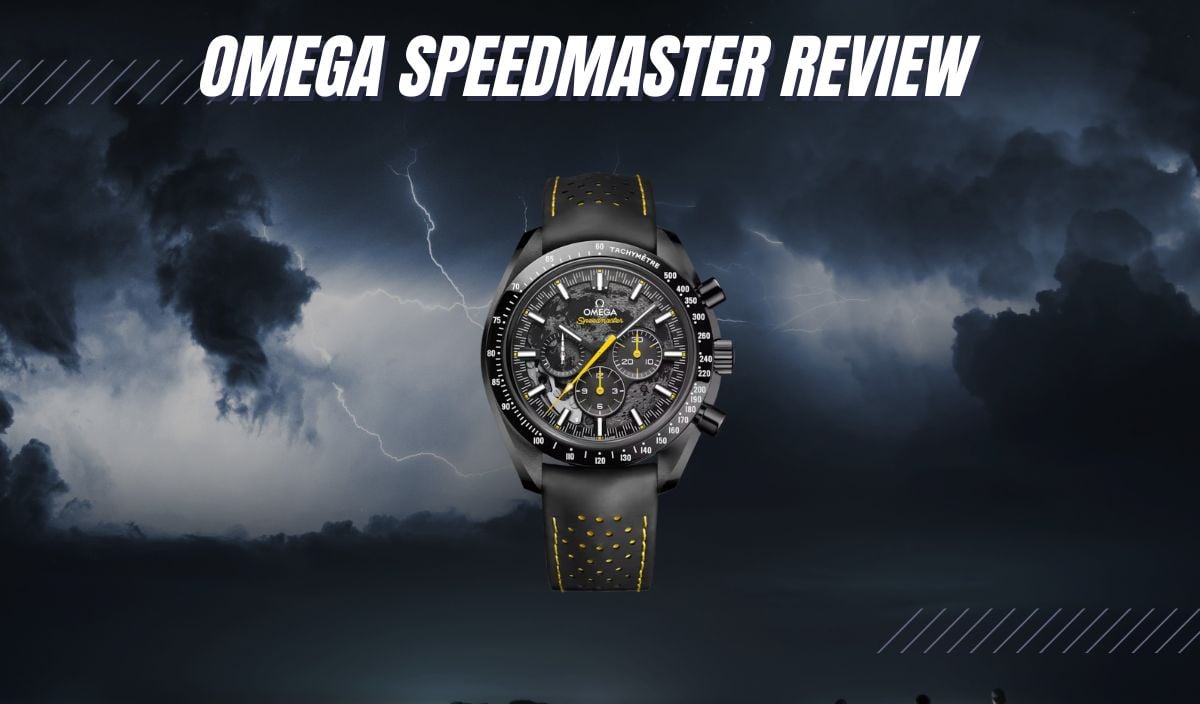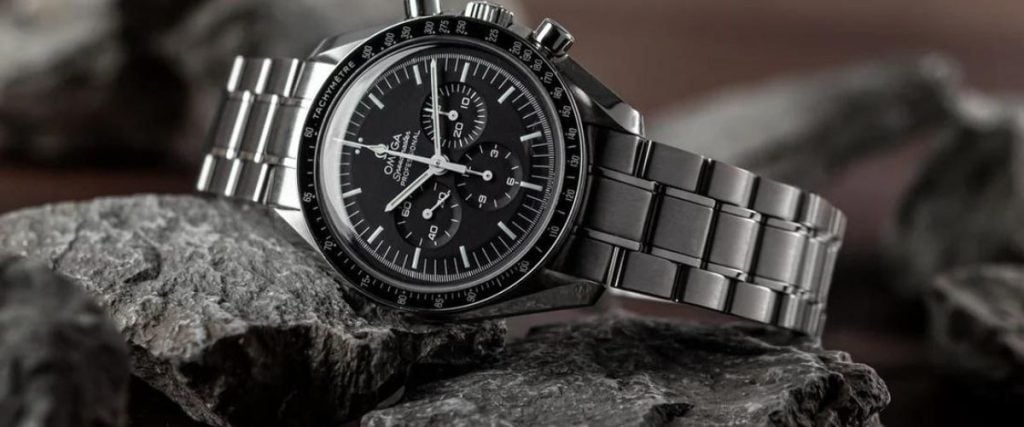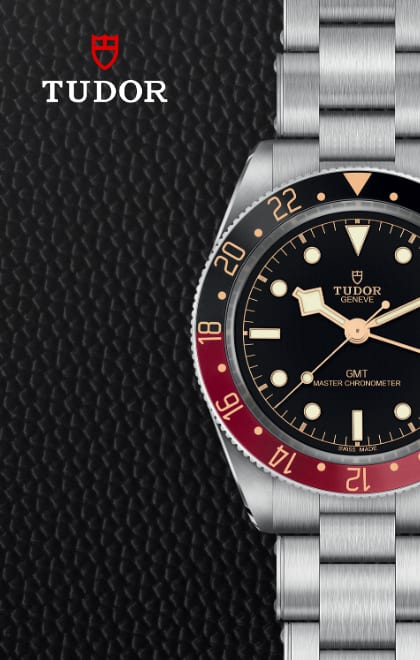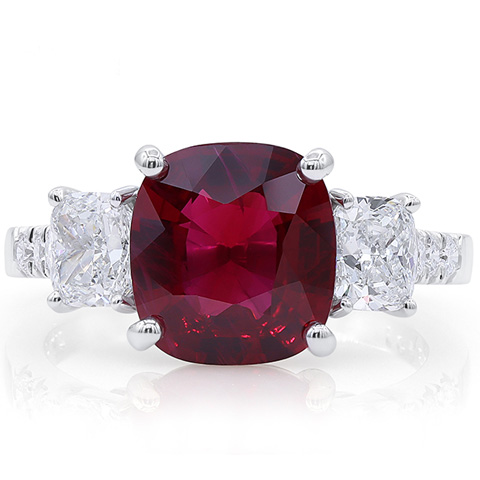
Omega Speedmaster Review: A Detailed Look of the “Moonwatch”
In the vast and often complex world of horology, there are only a few watches I’d seriously consider “holy grail” pieces. These are those rare gems that have not only left an indelible mark on history but continue to inspire watchmakers around the globe to create their own adaptations. They’re not just watches that tell the time but watches that are legendary for their interpretation of time. One such icon is the Omega Speedmaster.
This legendary black-dialed chronograph with its thin tachymeter bezel and five-row link bracelet has cemented itself a place in the pantheon of watchmaking greatness. The story of its birth is worthy of history books, and it has become a symbol of ingenuity, adventure, and timeless style. But, even today, years after its creation, this is a watch that remains high up on watch collector’s bucket lists.
About The Omega Speedmaster

I’m not really much of a chronograph wearer – mainly because they’re usually too big for my small wrists. And yet, if someone offered me an Omega Speedmaster watch, I’d take it in a heartbeat.
The model, first released in 1957, has quite easily become one of the main cornerstones in the world of chronographs and tool watches. Funnily enough, it was originally designed as a sports and racing chronograph, and its clean, functional design set it apart from other watches of that era. However, its history extended far beyond the race track, eventually becoming the first watch on the moon – but more on that shortly.
The Omega Speedmaster’s most defining features include its striking black dial, which provides excellent contrast and readability of its chronograph function, and the thin black tachymeter bezel that allows you to measure speed based on elapsed time.
There’s also often a five-link bracelet, adding both comfort and a handsome vintage appearance to the overall aesthetic, and a beautifully curved stainless steel case measuring 42mm wide.
History of Omega Speedmaster Watches
As mentioned, the story of the Omega Speedmaster began in 1957, starting with the introduction of the Speedmaster Ref. CK2915. It was originally designed as a sports and racing chronograph aiming to meet the needs of professional drivers – and, of course, watch enthusiasts who simply appreciate the adrenaline that goes with the racetrack.
Ironically, despite being a perfectly capable racing chronograph, the Omega Speedmaster didn’t find much success in its early years. In fact, it took half a decade and a rather significant journey into space to make that happen.
In 1962, NASA launched the Apollo program, a set of missions that planned to land humans on the moon for the first time and bring them back to Earth safely. A year later, NASA began their search for a watch that was reliable, durable, and legible enough to suit their astronauts in space. It would serve as the official watch of the Apollo program. In the end, four brands took their shot – Omega, Longines-Wittnauer, Rolex, and Hamilton.
As you’ve probably guessed, the only watch to pass the rigorous testing for use in space missions was the Omega Speedmaster, and its selection led it to become the official watch of the Apollo missions. The watch became no stranger to zero gravity and was most famously used by all three astronauts during the Apollo 11 mission in 1969. This included Neil Armstrong and Buzz Aldrin, who made history as the first humans to walk on the moon. And, of course, that made the Omega Speedmaster the first watch on the moon.
This historic event cemented the Omega Speedmaster as a legend and earned it its well-known nickname the “Moonwatch”. The exact reference to make it onto the moon’s surface was reference 105.012, boasting the very same 42mm wide steel case, black chronograph dial with luminous inserts, and thin tachymeter bezel familiar to all modern-day references. It also featured a manual-winding movement and vintage Hesalite crystal.
It’s no surprise that as the years went on, the Omega Speedmaster Moonwatch collection expanded to include new variations and technological improvements. One of the biggest upgrades was the introduction of the “Professional” designation, which further solidified its connection to space missions and professional use.
In the 1990s and early 2000s, Omega continued innovating while carefully respecting the Speedmaster’s heritage. Maintaining all the core characteristics of the original designs, such as the Speedmaster Professional “Moonphase” and the Speedmaster Reduced, brought new functionality and design variations to the collection. The brand also introduced the “Co-Axial” movement for enhanced precision and durability.
Sure, the original reference 105.012 will always be the “true” Moonwatch, but the models that have come after it are just as important. They are all deeply rooted in the original’s history, boasting all the essential features that make an Omega Speedmaster an Omega Speedmaster. They have just embraced modern advancements to ensure the design remains a relevant and sought-after timepiece.
Omega Speedmaster: In-Depth Review
As we’ve mentioned, the Omega Speedmaster Moonwatch Professional has been engineered in a number of different styles, but more often than not, they have a set few characteristics in common. Here are some of the essential features you can expect to find in an Omega Speedmaster.
A 42mm Steel Case
Other than a handful of the first Omega Speedmaster watches released (including the first reference CK2915 made for the racetrack), every true Moonwatch since has had a case size of 42mm. The inaugural models came in a little smaller – something typical of the time – measuring to 38.6mm and later 39.7mm. But in 1969, with the creation of the Omega Speedmaster that would make it onto the moon’s surface, the lyre lugs and crown guards increased the diameter of the watch to 42mm. And it’s been that way ever since.
Similarly, the rest of the dimensions have barely changed. The Omega Speedmaster Moonwatch Professional typically boasts a thickness of around 13mm, a lug-to-lug of 47mm, and a lug width of 20mm. It’s a really nice set of dimensions, allowing the watch to suit wrists anywhere from 6 inches and above. There are other Speedmasters that are smaller, but it’s worth noting these aren’t classed as “Moonwatches”.
The overall case shape is another permanent fixture, with the turned lug design borrowed from the classic Speedmaster’s silhouette. In the same way, the crown and chronograph pushers are placed in a traditional position, all recessed into the case just slightly for added durability. The crown is non-screwed down but does still warrant a 50-meter water-resistant rating.
The Omega Speedmaster Moonwatch Professional is most commonly found with a classic stainless steel case. The finishing is beautiful; it has brushed sides and high polish on the case and lug tops. There are also a handful of Moonwatch references in the Swiss watchmaker’s current collection made using their Sedna™, Canopus, or Moonshine Gold, a proprietary alloy developed by Omega.
The material offers a rich, long-lasting gold color and looks particularly stunning with the Speedmaster’s classic black dial. In some cases, gold is used for the entire case and bracelet, and in other instances, Omega has combined Sedna or Moonshine Gold with stainless steel for a cool two-toned finish. Although these models are beautiful for me, the classic stainless steel Speedmaster will always be my favorite.
A Black Tachymeter Bezel
Possibly one of the Omega Speedmaster Moonwatch Professional’s most defining characteristics is its tachymeter bezel. Most other space-inspired watches, or even tool watches for that matter, don’t have a tachymeter bezel because it’s used for measuring speed, typically related to the speed of a car on the racetrack. But since the Speedmaster was originally created for motorsport enthusiasts, the tachymeter continues to be a nod to its racing roots and a nice reminder that while the Speedmaster may have reached the moon, it was born on the racetrack.
The Speedmaster’s bezel is set on the outskirts of the case, kept nice and thin with a black aluminum insert. It has a wonderful glossy finish and is printed with the tachymeter scale in white. Some Omega Speedmaster Moonwatches feature a dot over the numeral for 90. Often referred to as “DO90”, this feature is a hallmark of early Speedmaster models and is highly prized by collectors for its historical accuracy and connection to the original design.
A Monochromatic Dial
Of course, the most famous dial color for the Omega Speedmaster Moonwatch Professional is the classic black display. Just like the reference to walk the Moon, most modern-day iterations of the design have a black matte finish with white printed markers and a slightly stepped architecture, which you’ll notice when you look at the minute track more closely. The three register displays for the chronograph and small seconds are also sunken for a nice touch of legibility.
The dial hardware isn’t oversized in any way but still offers a good amount of legibility. This is largely due to the contrasting white printing used on many markers and the luminescent material placed on the hands. The iconic Omega Speedmaster Professional logo is always positioned at 12 o’clock.
There are some other dial colors available in the Speedmaster collection, including green, white, silver, and gold. The white-dialed reference 310.30.42.50.04.001 is a personal favorite and a nice twist on the classic black display, switching around the colors for the surface and markers for a bright, legible finish.
Hesalite or Sapphire Crystal?
Understandably, while some of the original Omega Speedmaster watches featured domed Hesalite crystal glass, most of the modern re-interpretations have boasted contemporary scratch-resistant sapphire crystal. But there have been a handful of modern references that have brought back the Hesalite crystal for good reason. One of said references is 310.30.42.50.01.001.
Despite Hesalite being more prone to scratches, it does give the Omega Speedmaster a distinctly vintage finish featuring a higher dome and a very cool engraving of the Omega logo at the center of the crystal – a very small detail that’s fun to spot if you can! Meanwhile, sapphire crystal, although still slightly domed, does have a lower profile on the wrist, plus enhanced scratch resistance.
Ultimately, the choice between Hesalite and sapphire crystals will depend on your personal preferences. Those traditionalists who want an Omega Speedmaster as close to the original Moonwatch as possible will prefer those with Hesalite. On the flip side, those of you who prioritize durability will prefer scratch-resistant sapphire crystal.
It’s worth noting there is a small price difference between the two, with the Hesalite models retailing from $6,600 on the solid bracelet and the sapphire models priced at $7,600. The Hesalite references also have closed case backs engraved with the traditional Moonwatch message, while the sapphire crystal iterations keep things modern with a matching sapphire crystal exhibition back that lets you admire the movement inside.
Manual Winding Movements
Another notable change to the Omega Speedmaster over the years is the movement found within. Of course, as the years have gone by, Omega has drastically advanced its technologies for the better, but what’s really impressive is that although the technology has improved, the overall visuals and functionality have remained much the same.
Like the original, the majority of Omega Speedmaster Moonwatch Professional watches you’ll see are powered by manual-winding movements. These are the mechanical movements that require physical rewinding via the crown every few days.
One of the most used manual calibers in today’s current collection is the Omega 3861. This is a movement with a 50-hour power reserve, an anti-magnetic silicon balance spring, a free-sprung balance, chronograph complication, and chronometer certification.
It’s also one of just a few manual winding movements from Omega that uses a co-axial escapement. This is an escapement system that utilizes three pallets rather than the traditional two, which ultimately reduces sliding friction and increases service interval time. The Omega 3861 is also certified as a Master Chronometer by METAS, which includes more tests and higher standards for accuracy than chronometer certification alone.
Those who opt for an Omega Speedmaster Moonwatch with an exhibition case back will also be able to admire the architecture of the manual movement inside, which is laid out a lot like the original. It has rhodium plating and Geneva stripes across the bridges. Plus, you can spot some of the 26 jewels.
Leather, Rubber or Metal Strap Options
There are a handful of straps available to order with the Omega Speedmaster Professional Moonwatch. A popular choice is the black rubber strap, which on the surface appears just like any standard black rubber strap with a stainless steel folding buckle, but when off the wrist, you’ll notice the underside is uniquely textured. The reverse surface has a stunning texture reminiscent of the surface of the moon. It’s a really nice touch and a nod to the Speedmaster’s iconic history.
The Omega Speedmaster Moonwatch can also be ordered on a variety of comfortable NATO straps in several colors. Straps like this really help to elevate its vintage aesthetic. For a dressier look, you might prefer one of the leather straps, whether that be one of the smooth calfskin leather bands, shiny alligator leather, or perforated leather straps.
My personal favorite strap for the Omega Speedmaster is, without surprise, the metal bracelet. The five-row, pebble-like shape of the bracelet links is really beautiful, and the finishing varies depending on whether you opt for a Hesalite or sapphire crystal model. Those with Hesalite crystal are fully brushed, while the sapphire crystal references lean into its modern positioning by including polishing on the two smallest inner links.
Most Popular Omega Speedmaster Models
Explore the
Biggest Pre-Owned Collection of Luxury Watches
Now that you know all about the Omega Speedmaster, its history, and some of the defining characteristics that make a Speedmaster a true Speedmaster Moonwatch, you’re probably wondering which, out of the several models on the market, are the most popular. Without further ado, here’s the long-awaited answer…
Omega Speedmaster Moonwatch Professional Master Chronograph (ref. 310.30.42.50.01.002)

Of all the Omega Speedmaster Moonwatch Professional watches on this list, this is the one I’d choose for myself. Why? Because this is the closest to the original as it gets. You’re getting the same black tachymeter bezel, 42mm wide steel case, a matte black dial with white printing and lume, and a manual winding movement. It also arrives on the five-row link bracelet and has the sapphire crystal glass on both the front and back. It’s a beautiful watch through and through, and anyone looking to start a watch collection off with a bang can’t go wrong with this, trust me! Price: $8,000
Omega Speedmaster Moonwatch Professional Master Chronometer Moonshine Gold Green Dial on Bracelet (ref. 310.60.42.50.10.001)

If you love the history behind the Omega Speedmaster Moonwatch but you also want something a little dressier – or even a touch flashy -, we recommend the Omega Speedmaster Moonwatch Professional Master Chronometer Moonshine Gold Green Dial. This stunning watch arrives fully engineered from the brand’s 18ct Moonshine gold – which includes the case back, crown, pushers, and bracelet. In contrast, the dial is colored in a deep emerald green to match the green ceramic bezel ring with an Omega Ceragold™ tachymeter scale. Price: $42,600
Omega Speedmaster Moonwatch Professional White Dial (ref. 310.30.42.50.04.001)

I already mentioned previously that the Omega Speedmaster Moonwatch Professional White Dial was another of my favorites. I love how a simple swap of the black and white colors on the dial has transformed a classic looking chronograph into an obvious motorsport-inspired piece. It’s incredibly legible thanks to the jet black hands and numerals and maintains its 42mm wide diameter, steel case, black tachymeter bezel and the 3861 manual winding movement. Price: $8,100.
Omega Speedmaster Moonwatch Professional Master Chronometer Black Dial on Bracelet (ref. 310.60.42.50.01.001)

The Omega Speedmaster Moonwatch Professional under reference 310.60.42.50.01.001 is another luxury option for those wanting something with a bit of oomph. This time around, it pairs its matte black dial with beautiful rose gold hardware and a matching Sedna™ Gold case and bracelet. I’ve always thought rose gold and black look great together on watches, and this is a perfect example. It’s dressy and sophisticated, yet it still manages to uphold the sporty personality of the Speedmaster name. Price: $42,600.
Omega Speedmaster Moonwatch Professional Master Chronograph Canopus Gold (ref. 310.60.42.50.02.001)
Last but certainly not least, we have an Omega Speedmaster Moonwatch Professional engineered from the Swiss watchmaker’s patented Canopus Gold™ material. This is one of those metals you have to see in person to appreciate. As well as being 100% noble, it boasts a beautiful brilliance and whiteness that makes it stand out against traditional white gold and stainless steel watches. The inclusion of the stepped silver dial gives it an almost completely monochromatic look, with just the black tachymeter scale standing out in a different hue. It’s another beautiful watch worthy of any watch collector’s wish list. Price: $55,500.
Should You Buy An Omega Speedmaster?
I’m not sure there’s an easier question to answer. Yes, you should absolutely buy an Omega Speedmaster – especially those in the dedicated Moonwatch collection. If you’re a watch enthusiast who appreciates brilliant history and exquisite craftsmanship, there are very few watches that will beat this. For many, it’s a “holy grail” watch, completing collections new and old. From its legendary journey to the moon to its mass of impressive technology inside, the Speedmaster will appeal to anyone with a passion for horology.
Omega Speedmaster Pricing & Availability
With there being so many Omega Speedmaster Moonwatches out here, the prices can vary depending on exactly which model you have in mind. The stainless steel references typically retail from around $6,600 while some of the full 18ct gold references with diamonds can sit with a price tag as large as $60,200. If budget is your issue, it’s definitely worth checking out authorized retailers like Exquisite Timepieces for the latest offers or heading to the second-hand market where you can find steel Speedys for around $4,000.
Conclusion
We hope this deep dive into the Omega Speedmaster has explained exactly why this watch is a true legend in the world of horology. Sure, the Rolex Submariner and the Audemars Piguet Royal Oak are nice, but none of those can claim to be the first watch to set foot on the moon. And despite it being several decades old, it’s clear the Omega Speedmaster continues to captivate, both with its exciting history and its incredible design. This is a daily-beater watch with a story and plenty of high-tech to boot. What more could you want?
About Exquisite Timepieces
Established in 1998, Exquisite Timepieces is your one-stop shop for all things luxury watches! We are an authorized dealer for 60+ luxury watch brands including Omega, Hublot, Seiko, & Longines! We are proud to showcase one of the world’s largest pre-owned watch collections, including renowned brands like Rolex and Patek Philippe. Check out our brand new watch arrivals here and popular pre-owned listings here.




















